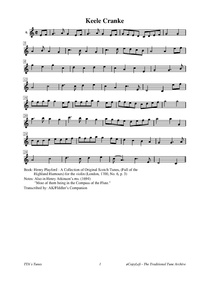Template:Pagina principale/Vetrina: Difference between revisions
No edit summary |
No edit summary |
||
| Line 1: | Line 1: | ||
{{SheetMusic | {{SheetMusic | ||
|f_track= | |f_track=Killiecrankie.mp3 | ||
|f_pdf= | |f_pdf=Killiecrankie.pdf | ||
|f_artwork= | |f_artwork=Lochiel's_charge_at_Killycrankie.jpg | ||
|f_tune_name= | |f_tune_name=Killiecrankie | ||
|f_track_title= | |f_track_title=Killiecrankie_(1) | ||
|f_section=abc | |f_section=abc | ||
|f_played_by=[https://soundcloud.com/ | |f_played_by=[https://soundcloud.com/natalie-macmaster Natalie McMaster] | ||
|f_notes= | |f_notes= The charge of the Cameron Jacobite forces at the Battle of Killiecrankie. | ||
|f_caption= | |f_caption=The title commemorates the famous Battle of Killiecrankie, Perthshire, in 1689 between the Highland forces led by Claverhouse in support of the Catholic King James II, and the Protestant Major-General Hugh Mackay, leader of the army of William III (although composed primarily of Lowland Scots). | ||
|f_source=[https://soundcloud.com/ | |f_source=[https://soundcloud.com/natalie-macmaster/killiecrankie Soundcloud] | ||
|f_pix=420 | |f_pix=420 | ||
|f_picpix=200 | |f_picpix=200 | ||
|f_article=[[ | |f_article=[[Killiecrankie_(1) | '''Killiecrankie''']] | ||
The name Killiecrankie is derived from the Gaelic root word coille, meaning a wood, coupled with 'crankie,' which refers to aspens; thus the phrase means 'wood of the aspens' (Matthews, 1972). | |||
Johnson (1983) states it was later renamed after another (different) battle called Tranent Muir, East Lothian, fought in 1745 {which battle is usually known as the Battle of Prestonpans}. He suggests on stylistic reasons that the tune may be the surviving opening for a battle pibroch (see "Highland Battle, A"), although no other parts have come down. The tune, as "Keel Cranke" was published by Henry Playford in his 1700 collection of Scottish tunes (Original Scots Tunes), however, the earliest printing of the song appears to be in the Leyden Manuscript of c. 1692, according to John Glen (Early Scottish Melodies). | |||
Glen further states: "That portion of ("Killiecrankie") which is sung to the chorus is still more ancient; it forms part of the tune called "My Mistres blush is bonny" (sic) in the Skene Manuscripts" (c. 1615). Glen dates the Leyden Manuscript by its inclusion of tunes referring to 'King James March to Ireland' and the "Watter (sic) of the Boyne," a reference to the Jacobite Wars. | |||
As "Irish Gillycranky (The)" it is included in the Henry Atkinson manuscript of 1694/95. "Killiecrankie" was set for violin and continuo by William MacGibbon (1695-1756), and was printed by Oswald in his Caledonian Pocket Companion. | |||
}} | }} | ||
Revision as of 11:11, 1 July 2023

Played by: Natalie McMaster
Source: Soundcloud
Image: The charge of the Cameron Jacobite forces at the Battle of Killiecrankie.

The name Killiecrankie is derived from the Gaelic root word coille, meaning a wood, coupled with 'crankie,' which refers to aspens; thus the phrase means 'wood of the aspens' (Matthews, 1972).
Johnson (1983) states it was later renamed after another (different) battle called Tranent Muir, East Lothian, fought in 1745 {which battle is usually known as the Battle of Prestonpans}. He suggests on stylistic reasons that the tune may be the surviving opening for a battle pibroch (see "Highland Battle, A"), although no other parts have come down. The tune, as "Keel Cranke" was published by Henry Playford in his 1700 collection of Scottish tunes (Original Scots Tunes), however, the earliest printing of the song appears to be in the Leyden Manuscript of c. 1692, according to John Glen (Early Scottish Melodies).
Glen further states: "That portion of ("Killiecrankie") which is sung to the chorus is still more ancient; it forms part of the tune called "My Mistres blush is bonny" (sic) in the Skene Manuscripts" (c. 1615). Glen dates the Leyden Manuscript by its inclusion of tunes referring to 'King James March to Ireland' and the "Watter (sic) of the Boyne," a reference to the Jacobite Wars.
As "Irish Gillycranky (The)" it is included in the Henry Atkinson manuscript of 1694/95. "Killiecrankie" was set for violin and continuo by William MacGibbon (1695-1756), and was printed by Oswald in his Caledonian Pocket Companion.
...more at: Killiecrankie - full Score(s) and Annotations
X:1 T:Keele Cranke M:C| L:1/8 B:Daniel Wright - Aria di Camera (London, 1727, No. 50) N:”being A Choice Collection of Scotch, Irish & Welsh Airs N:for the Violin and German Flute by the following masters N:Mr. Alex. Urquahart of Edinburgh, Mr. Dermot O'Connar of Limrick N:Mr. Hugh Edwards of Carmarthen” F: https://ia600808.us.archive.org/20/items/AriaDiCamera1727/Wright-AriaDiCamera-1727.pdf Z:AK/Fiddler's Companion K:D V:1 clef=treble name="1." [V:1] FG|A3B A2 FG|A3 B A2FG|AGFE DEFG|A4 A4| B3c B2A2|d3c B2A2|d3e fedc|B4 B2 fg| a2f2a2d2|e2d2e2f2|d2B2d2F2|A4 A3c| B4 d4|e3d e2f2|d2B2d3F|E4 D2|| fg|agab a2 fg|agab a2 fg|agfe defg|a4 a4| b3c'b2a2|d'3ab2a2|bagf efga|b4 b2A2| dcde fefg|agab a2 gf|e2d2c2B2|A4 A3c| B4d4|e3d e2f2|(dB3) d3F|E4 D2||
